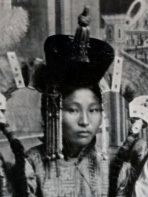Role Damdin Sukhbaatar\'s wife Spouse Damdin Sukhbaatar | Name Sukhbaataryn Yanjmaa | |
 | ||
General Secretary Yumjaagiin TsedenbalDashiin Damba Political party People\'s Revolutionary Party Died 1963, Ulaanbaatar, Mongolia | ||
Sükhbaataryn Yanjmaa (Mongolian: Сүхбаатарын Янжмаа born Nemendeyen Yanjmaa, Mongolian: Нэмэндэен Янжмаа; February 15, 1893 – 1 May 1962) was the widow of Mongolian revolutionary leader Damdin Sükhbaatar, who as Chairperson of the Presidium of the State Great Khural from September 1953 to July 1954 became only the second woman in history to be elected or appointed head of state.
Life
Yanjmaa was born on February 15, 1893 into a poor herding family near present-day Ulaanbaatar. She worked for Sükhbaatar's revolutionary group as a messenger in 1919 and when her husband traveled to the Soviet Union in 1920 to establish contact with Bolshevik revolutionaries, Yanjmaa stayed behind in Ulaanbaatar with their son, evading capture from Chinese officials hunting down subversives. In 1921 Khorloogiin Choibalsan helped her and her son flee to Kyakhta to be reunited with Sükhbaatar.
After her husband led Mongolian partisans to victory in the Outer Mongolian Revolution of 1921, Yanjmaa became a member of the Mongolian Revolutionary Youth League (MYRL). When Sükhbaatar died in 1923, she adopted "Sükhbaataryn" in place of her patronymic Nemedeyen and joined the Mongolian People's Revolutionary Party (MPRP) a year later in 1924. As a member of the party Central Committee and of the Presidium of the Central Committee, she represented the MPRP at the Third International Conference of Communist Women (where she met Clara Zetkin and Nadezhda Krupskaya) and the Fifth World Congress of the Comintern in Moscow, both in 1924. She was involved in the creation of Mongolia's first trade union in 1925. From 1927 to 1930 she studied at the Communist University of the Toilers of the East in Moscow. In 1933 Yanjmaa headed the newly created women's section of the MPRP Central Committee where she focused on developing women's educution.
From 1940 until 1954, Yanjmaa served on the MPRP politburo and was Secretary of the party's Central Committee from 1941 until 1947. She was a member of the Presidium of the Little Khural (the executive committee of the State Great Khural, or Parliament) from 1940 to 1950. During World War II Yanjmaa helped raise funds to support the Soviet Union for which she was awarded the Soviet Order of the Red Banner of Labour in 1946. In 1945 she was elected a member of the Women's International Democratic Federation (WIDF).
Yanjmaa was as a member of the People's Great Khural from 1950 to 1962. Following the death of Gonchigiin Bumtsend, she became acting President of Mongolia for the transitional period, lasting from 23 September 1953 until 8 July 1954. This made her the second woman in the role of formal head of state of a republic, after Khertek Anchimaa-Toka in the Tuvan People's Republic.
